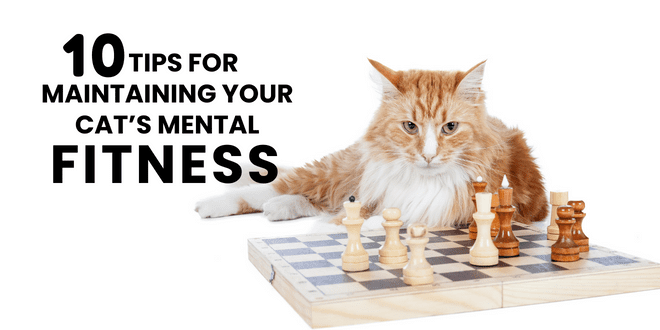
You’ve heard the saying “a mind is a terrible thing to waste” and that applies to your Feline Einstein as well. Your cat has a remarkable brain and it needs to be challenged, stimulated, and exercised to help maintain good mental fitness. Here are 10 tips to help get you started:
1. Play With Your Cat
Engage in daily interactive play sessions where you move the toy like prey so your cat can use those incredible hunting skills. A fishing pole/wand-type toy is best for interactive sessions because it puts a distance between the cat’s teeth and your fingers. The wand toy also allows you to move the toy in a way that entices the cat’s play response. A well-done interactive play session gives your cat the opportunity to plan out a stalking technique and perfect his pounce timing. When a cat hunts, he counts on mental skill just as much as physical ability so incorporate that into the game. Let the “prey” hide periodically or quiver instead of always doing non-stop frantic movements. It’s the time prey is still or distracted that the cat will plan his advance to get within striking distance. It’s also important to make the game rewarding and satisfying. Let your cat have several captures throughout the play session.
Schedule play sessions at least twice a day for about 15 minutes each. This regularly scheduled time of physical and mental exercise is beneficial to your cat’s health and confidence. It’s also wonderful for strengthening the bond you share with your cat.
Put interactive toys away after each session to prevent your cat from getting tangled up in the string.
2. Make Mealtime Fun for Your Cat
Instead of heaping a pile of food into your cat’s bowl, use puzzle feeders so he gets the chance to work for food and get a reward for a job well done. This feeding method provides entertainment for your cat while keeping him mentally stimulated. You can find puzzle feeders in your local pet supply store or online. You can also make your own. For dry food, cut holes in a plastic water bottle and place some pieces of dry food in there. Be sure the holes are large enough for the kibble to easily spill out when the cat bats at the bottle. For wet food, a simple puzzle feeder can be made out of a plastic ice cube tray or egg carton. Place a little drop of wet food in each cube compartment. You can also make puzzle feeders out of plastic Easter eggs by cutting a hole in them and placing a few treats inside. If you look online you can find lots of creative ideas for homemade puzzle feeders. Note: if you also share your home with a dog, the cat puzzle feeders must only be available in dog-free zones of the house.
3. Hide-and-Seek Solo Cat Playtime
The solo toys your cat has for playtime (such as the fuzzy mice, balls, etc.) can be strategically placed around the house so kitty can “discover” them all over again. It helps keep your cat’s brain active as he walks through the house. Place toys so they “peek” out from corners or sit enticingly on the edge of a cat perch. Place a fuzzy mouse or a ping pong ball inside of an empty tissue box or open paper bag (bag handles need to be cut off). Use your imagination so the toys aren’t just left sitting in a pile day after day. Rotate toys as well to create a renewed interest.
4. Clicker Train Your Cat
This training method is great for helping with behavior problems but it’s also just plain fun and a wonderful way to mentally challenge your cat. You can clicker train kitty to perform behaviors such as giving a high five, jumping through a hope, or sitting up on hind legs, to name just a few. If you’re dealing with a cat behavior problem, this form of training can be a great language between you both. For example, if your cat is fearful, you can use clicker training to reward for the smallest of baby steps out of his comfort zone. If you have cats who don’t get along, clicker training is a wonderful way to help them develop positive associations. Clicker training has so many uses. I encourage you to learn more about it.
5. Prevent Loneliness and Boredom in Your Cat
Start with environmental enrichment, which incorporates the things I discussed in the previous sections. How interesting, from a cat’s point of view, is your indoor environment? Are there places to climb and perch? Do you provide plenty of opportunities for exploration, fun and stimulation? Environmental enrichment is a phrase you may or may have heard, but it’s an important aspect of a healthy, happy cat life. A boring environment can contribute to problems such as destructive behavior, aggression, depression, and anxiety. Cats who are under-stimulated are at risk of developing boredom-related or stress-relieving behaviors such as over-grooming, chewing non-food items, picking on companion pets, becoming isolated from family, over-eating, compulsive behaviors, and loss of appetite. Look at ways to create fun and stimulation within your environment. It starts with first making sure your cat feels safe and secure, and that there are plenty of resources available in areas in easily accessible areas. Next, add opportunities for exploration (playtime, puzzle feeders), climbing (cat trees), resting (perches and cat shelves, bedding), scratching (good scratching posts), visual stimulation, olfactory stimulation, companionship, and the list goes on. Environmental enrichment doesn’t have to break the budget and it doesn’t mean you have to redo your whole house. Look around and see what needs tweaking to make life more fulfilling. Whether you do some simple indoor changes or go all out by building cat walkways and creating a safe outdoor enclosure, base your decisions on what you know about your cat’s personality.
For some cats, the addition of a companion cat is a great way to fight loneliness especially when the cat parent is away from home for long periods of time. Having a cat companion to play with creates lots of opportunities for playtime and mental fitness. If you don’t think your cat will do well with another cat, consider getting a dog, if you think your cat will be accepting of that addition. If you decide to add a cat or dog companion, you’ll need to do a careful, gradual, positive introduction. The last thing you want to do is introduce more stress into your cat’s life. Carefully think through this option and don’t make an impulsive decision. Not all cats want to share their home with another cat or dog so use what you know about your cat when considering that life change.
In terms of the human family, focus on interacting with the cat in ways your cat enjoys to maximize the bonding process. Having a cat isn’t just about providing food, a litter box, and shelter. It’s about the human/animal bond. Spend time with your cat. If your cat doesn’t like to be held but enjoys sitting near you, don’t force the issue by forcing physical closeness. Watch body language and respond accordingly to build trust.
6. Do Homemade Agility Training with Your Cat
Start with something basic such as having your cat go through a paper bag tunnel and then add to the course with various obstacles. This is a great combination of mental and physical exercise. You can use an embroidery hoop as an obstacle for your cat to jump through. You can find agility objects online but you can also easily make basic homemade ones. Even teaching your cat to jump from one chair to another is a start. Just make sure you keep agility training fun for your cat and well within his physical ability. Clicker training is often used with agility training. If you have children, they might enjoy training your cat in basic, fun agility training. Keep sessions short, fun and positive.
7. Socialize Your Kitten
Begin this early and you’ll have an cat who has an easier time adjusting to change, handling, accepting visitors in the home and enjoying more out of life. With a kitten, gradually and gently expose him to different experiences such as being handled, being in the carrier, travel, household noises, people, etc., so these things don’t take your cat by surprise later in life. Start interactive playtime when your kitty is young to train him to focus those sharp little teeth and claws at appropriate objects. Your kitten is learning things every day and whether he learns constructive things or not is totally up to you. Be a good teacher.
8. Minimize Stress for Your Cat
Address issues that could be causing unhealthy stress to your cat. This could include a tense relationship with a companion pet, improper training, punishment, or living in chaotic environmental conditions. Stress is a big enemy of cats. Pay attention to any changes, whether they are physical or behavioral, and talk to your veterinarian. Very often, a small change in behavior may be the first sign your cat is having trouble dealing with something. It may be that your normally playful cat has started hiding or maybe there’s a change in appetite. Get a veterinary check-up to rule out any underlying medical cause and then do the needed pet detective work to find the cause of your cat’s stress.
9. Address Your Cat’s Behavior Problems
If your cat is experiencing a behavior problem, address it early and appropriately so their brain can focus on the good things in his life. Don’t punish your cat for behavior issues. Keep in mind that what you may label as a misbehavior is actually a normal behavior for the cat. Your cat isn’t doing something unwanted to be deliberately bad and he isn’t doing something to get back at you. Behaviors are repeated because they serve a purpose for the animal. It’s up to you to figure out what the cat is asking for and address those needs. For example, a cat who pees outside of the litter box may be doing so because of a medical issue. It could also be because the litter box conditions are not appealing or maybe he doesn’t feel safe there due to past experiences of being ambushed by a companion cat. A cat may be scratching the sofa because there isn’t a scratching post provided or maybe the one in the home isn’t sturdy enough. Figure out what your cat is trying to accomplish by the behavior so you can create a better alternative. If you don’t feel equipped to handle the behavior issue, contact your veterinarian for a referral to a certified behavior expert.
10. Maintain Your Cat’s Good Health
Help your cat stay active, feed a diet that is appropriate for your cat’s age, health, and physical condition, have routine veterinary exams, and stay on top of any potential medical issue. If you have a senior cat, pay close attention to subtle changes that could indicate increased pain or age-related problems. Don’t skip routine veterinary exams just because your cat looks well. Don’t wait until a potential medical issue becomes visible — catch problems in their earliest stage.
It’s Never too Early or too Late
If you have a kitten, now is the time to begin mental fitness training and maintain it as he grows so you’ll increase the chances of slowing the progression of age-related brain issues later in life. If your cat is already a feline senior citizen, keep that brain active to help slow the deterioration and improve quality of life. Your cat may not be able to manage the more difficult puzzle feeders but may enjoy the more basic ones or even just having a schedule of twice daily interactive play sessions. The key to success is to establish a plan that is appropriate for your cat’s age, health and physical ability, and then maintain the routine.
Need More Information?
For more specific information on cat training or cat behavior problems, refer to any of the books by best-selling author Pam Johnson-Bennett. Pam’s books are available at bookstores and online. We’ve included links to Amazon here on our website.
If you have a question regarding your cat’s health, please contact your veterinarian. This article is not intended as a replacement for your cat’s veterinary care.





